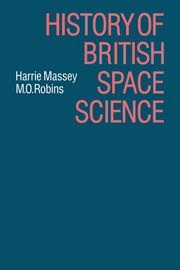Book contents
- Frontmatter
- Contents
- Glossary of abbreviations in text and annexes
- Glossary of abbreviations in appendices
- Preface
- 1 The scientific background
- 2 The technical background
- 3 The initiation of the Skylark rocket programme – the IGY and artificial satellites
- 4 Post-IGY developments – NASA – COSPAR – British National Committee for Space Research – British satellite experiments
- 5 The Ariel programme
- 6 The European Space Research Organization
- 7 Commonwealth co-operation in space reseach
- 8 Smaller rockets for scientific purposes – Skua and Petrel
- 9 Attitude controlled Skylark rockets
- 10 The Trend Committee and the Science Research Council
- 11 The transformation of ESRO into ESA
- 12 The Space Science Committee for Europe
- 13 Scientific studies by British space scientists – figure of the earth and the neutral atmosphere
- 14 Scientific studies by British space scientists – the ionosphere, the magnetosphere and cosmic rays
- 15 The contribution from British space scientists to astronomy
- 16 Concluding remarks
- Appendices
- Annexes
- Notes
- Index
3 - The initiation of the Skylark rocket programme – the IGY and artificial satellites
Published online by Cambridge University Press: 05 February 2012
- Frontmatter
- Contents
- Glossary of abbreviations in text and annexes
- Glossary of abbreviations in appendices
- Preface
- 1 The scientific background
- 2 The technical background
- 3 The initiation of the Skylark rocket programme – the IGY and artificial satellites
- 4 Post-IGY developments – NASA – COSPAR – British National Committee for Space Research – British satellite experiments
- 5 The Ariel programme
- 6 The European Space Research Organization
- 7 Commonwealth co-operation in space reseach
- 8 Smaller rockets for scientific purposes – Skua and Petrel
- 9 Attitude controlled Skylark rockets
- 10 The Trend Committee and the Science Research Council
- 11 The transformation of ESRO into ESA
- 12 The Space Science Committee for Europe
- 13 Scientific studies by British space scientists – figure of the earth and the neutral atmosphere
- 14 Scientific studies by British space scientists – the ionosphere, the magnetosphere and cosmic rays
- 15 The contribution from British space scientists to astronomy
- 16 Concluding remarks
- Appendices
- Annexes
- Notes
- Index
Summary
In Chapter 1 we described the way in which the Gassiot Committee of the Royal Society had been taking the lead in developing a research programme in atmospheric (including upper atmospheric) physics, through its three sub-committees, since 1941. It was natural that the Committee would take a close interest in the development going on in the USA in the use of rockets as vehicles to transport scientific instruments to high altitudes in the atmosphere. The chapter concluded with an account of the arrangements made by the Committee in conjunction with the US Rocket Research Panel to hold an international conference in Oxford in 1953 on rocket exploration of the upper atmosphere.
Prelude to the conference – an offer of rockets
The atmospheric scientists up to this time were quite unaware of the work proceeding in the Ministry of Supply on the design and development of rockets in connection with ballistic missile development, described in Chapter 2. It so happened, however, that the American Scientific liaison officer in London, F. Singer, had a wide interest and involvement in both the scientific and technological aspects of space exploration. He knew the key figures in the Ministry of Supply concerned with rocket development and suggested to the Chairman of the Gassiot Committee that invitations to attend the Conference be sent to a number of these people. This was done immediately and was much appreciated as it opened to them a window on the outside scientific world interested in using their products.
- Type
- Chapter
- Information
- History of British Space Science , pp. 16 - 53Publisher: Cambridge University PressPrint publication year: 1986



